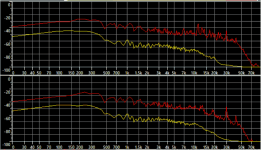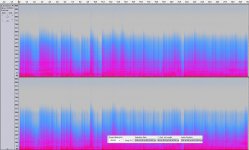I'm game, will give it a try.
Beyond 60k or so there does not seem to be any correlation to the rest of the content in fact it looks like typical noise shaped dither.
Beyond 60k or so there does not seem to be any correlation to the rest of the content in fact it looks like typical noise shaped dither.
I think it is result from Audacity's normalization function... . Attached plot is showing non-normalized spectrum.
Attachments
Last edited:
OK, I took the signal and ran a 20K low pass filter. Verified no content above 22K.
Then ran a hard overdrive distortion effect on it and high passed that at 22K. Now plenty of >20K content. Results are very similar to the content of the original signal, but a little harsher. I suspect the style of harmonic effect is the reason. Still follows the rhythm of the song, same channel balance.
It certainly could be distortion on the original. Maybe from the cutter head or its amp? It's interesting that this content is only found on a few rare LPs. It doesn't sound like anything not related to the sub 20K content. I.E. not noise.
Then ran a hard overdrive distortion effect on it and high passed that at 22K. Now plenty of >20K content. Results are very similar to the content of the original signal, but a little harsher. I suspect the style of harmonic effect is the reason. Still follows the rhythm of the song, same channel balance.
It certainly could be distortion on the original. Maybe from the cutter head or its amp? It's interesting that this content is only found on a few rare LPs. It doesn't sound like anything not related to the sub 20K content. I.E. not noise.
...
It certainly could be distortion on the original. Maybe from the cutter head or its amp? It's interesting that this content is only found on a few rare LPs. It doesn't sound like anything not related to the sub 20K content. I.E. not noise.
This (bold) is the reason why I started discussion of it back in 2014 on an other audio related forum. Brought this in discussions here because of reply by @iperv:
3 i don't think it's an excellent idea to cut away frequencies above 20KHz.
One of the best part of a vynil record is it eventually doesn't cut frequencies above 20KHz, as per red book, but it is very common to see records with an audio band until 60KHz.
Of course one cannot listen to that frequency, but the effects of modulation still reflects on in-band contents.
So, to be really perfect, it's necessary to think the audio band - and the riia file too - from 20Hz to 60KHz.
for my suggestion to use LPF at around 20kHz.
Since my old phono cart doesn't go nearly that high, this will not be of any concern to me. 🙂 But it is interesting that this >20 kHz content does show up on some LPs. It certainly seems to be signal related and not noise - but what causes it? Is it actual content from the master, or is it distortion in the cutting process?
Has this been seen in direct to disk recordings?
Has this been seen in direct to disk recordings?
...
But it is interesting that this >20 kHz content does show up on some LPs. It certainly seems to be signal related and not noise - but what causes it? Is it actual content from the master, or is it distortion in the cutting process?
...
Back in 2014, on that other forum, I got reply by Steve Grant:
...
Doug Self in his Small Signal Audio book (page 168) explains about the 50kHz roll off in Neuman SAL 74B cutters and, according to him, there is a 2 pole roll off at 3.19uS giving 12dB/Octave Roll off. The loss at 20kHz is less than 0.1dB.
I worked for Westrex until its demise in 1984 and our cutters also had a 49.9Khz roll off.
I'd vote for most stuff above 15kHz being HD, but may be part of the 'vinyl sound'so not going to knock anyone who keeps it. My DSP is 96kHz so that will be my top sample rate. My speakers start to roll off around 16kHz anyway, my ears even earlier so I'm not fussed 🙂
I've been playing around with SigmaStudio for the ADAU1701 DSP and would like to use it for my RIAA filter. I have a software setup I'd like to test (biquads from scott's articles in linear audio) but I need to wrap my head around the hardware side of things before I can try it all out.
I use an AT132 cart with an AT152 needle (thanks to billshurv 😀 ). The AT132 doesn't need any more capacitance beyond the few pf the phono cable provides but does need its 47k resistive load to work.
As I'm quite new to electronics I bought a stereo buffer based around two NE5534A and changed the resistors in the feedback loop to give me about 30dB gain. My plan is to use this with added 47kohm resistors to bring the cart's output up to a level that the DSP can work with.
Does this sound like it might work? Will I blow something up?
Bill, how do you connect your cart to your minidsp?
I use an AT132 cart with an AT152 needle (thanks to billshurv 😀 ). The AT132 doesn't need any more capacitance beyond the few pf the phono cable provides but does need its 47k resistive load to work.
As I'm quite new to electronics I bought a stereo buffer based around two NE5534A and changed the resistors in the feedback loop to give me about 30dB gain. My plan is to use this with added 47kohm resistors to bring the cart's output up to a level that the DSP can work with.
Does this sound like it might work? Will I blow something up?
Bill, how do you connect your cart to your minidsp?
I've been playing around with SigmaStudio for the ADAU1701 DSP and would like to use it for my RIAA filter. I have a software setup I'd like to test (biquads from scott's articles in linear audio) but I need to wrap my head around the hardware side of things before I can try it all out.
I use an AT132 cart with an AT152 needle (thanks to billshurv 😀 ). The AT132 doesn't need any more capacitance beyond the few pf the phono cable provides but does need its 47k resistive load to work.
As I'm quite new to electronics I bought a stereo buffer based around two NE5534A and changed the resistors in the feedback loop to give me about 30dB gain. My plan is to use this with added 47kohm resistors to bring the cart's output up to a level that the DSP can work with.
Does this sound like it might work? Will I blow something up?
Bill, how do you connect your cart to your minidsp?
You will not blow anything.
Try.
And if it is too low, try 36dB of gain, and so on.
47K at input.
To be perfect:
AT132 has an output of 5mV peak.
For your dsp you want likely 1V peak.
1/5m = 200.
Gain is 200, or 46dB.
So, 30dB is too low.
Last edited:
This (bold) is the reason why I started discussion of it back in 2014 on an other audio related forum. Brought this in discussions here because of reply by @iperv:
for my suggestion to use LPF at around 20kHz.
In the end...
I still didn't understand if there is signal that deserves to be saved above the 20KHz.
In the end...
I still didn't understand if there is signal that deserves to be saved above the 20KHz.
The answer is "no", unless you are a dog or a bat.
@ Julf ..... not sure you're allowed to say 'b#t' 🙂
https://www.diyaudio.com/forums/site-announcements/352050-medical-threads.html#post6143807
https://www.diyaudio.com/forums/site-announcements/352050-medical-threads.html#post6143807
Bill, how do you connect your cart to your minidsp?
Ah well I haven't yet*. I've been doing the usual silly thing and collecting projects faster than I can complete them. What I have is a balanced flat phono board that gives +14 to +46dB gain that will go into the balanced inputs on the miniDSP. That will be one of the solutions and the closest to getting running. I also have two more experimental solutions in progress as long term I want to play around with some none standard MM loading schemes. All part of a long delayed plan to see if I can get evidence of mechanical resonance in MM cartridges. I don't expect any huge sonic breakthroughs, this is all for a bit of fun.
*By which I mean for digital RIAA. It's currently running out of an old phono stage into the unbalanced inputs and working nicely.
The answer is "no", unless you are a dog or a bat.
The fact i'm a cat or a dog still doesn't explain if there is signal above 20KHz in vinyl records.
And it doesn't seem you have provided (any) evidence to support your thesis, which is very clear and I guess it is no longer necessary to reiterate the concept.
There are also other participants in this discussion.
The fact i'm a cat or a dog still doesn't explain if there is signal above 20KHz in vinyl records.
I think there has been a fair bit of indication that the "signal" is just harmonic distortion, but even if it would be music content, how does it affect you if you can't hear it?
Au contraire, my friend, I have provided ample evidence (see the frequency response of vinyl pickups), and you can also look up any scientific paper on the limits of human hearing.And it doesn't seem you have provided (any) evidence to support your thesis
On the other hand, there has been no evidence whatsoever that response above 20 kHz makes any difference.
I suggest you study the concepts of "burden of proof" and "null hypothesis". I can't provide absolute proof that 5G mobile phones don't cause covid-19, but that is still no reason to believe they do.
Indeed. Several of them have weighed in, but you seem to filter responses somewhat selectively. Confirmation bias at work?There are also other participants in this discussion
Ah well I haven't yet*. I've been doing the usual silly thing and collecting projects faster than I can complete them. What I have is a balanced flat phono board that gives +14 to +46dB gain that will go into the balanced inputs on the miniDSP. That will be one of the solutions and the closest to getting running. I also have two more experimental solutions in progress as long term I want to play around with some none standard MM loading schemes. All part of a long delayed plan to see if I can get evidence of mechanical resonance in MM cartridges. I don't expect any huge sonic breakthroughs, this is all for a bit of fun.
*By which I mean for digital RIAA. It's currently running out of an old phono stage into the unbalanced inputs and working nicely.
Of course balanced is always a good thing when there's a fight against the noise.
- Home
- Source & Line
- Digital Line Level
- What about digital RIAA?

